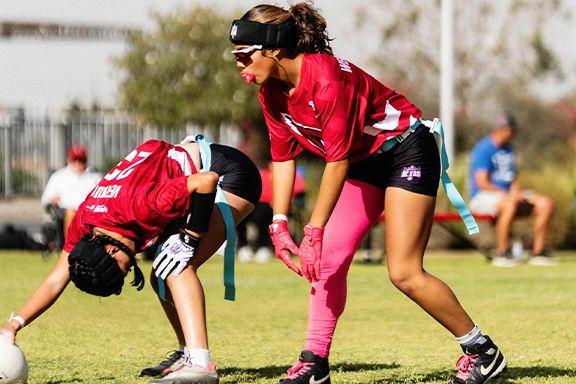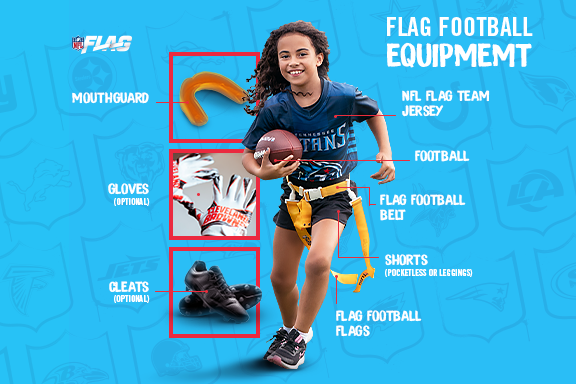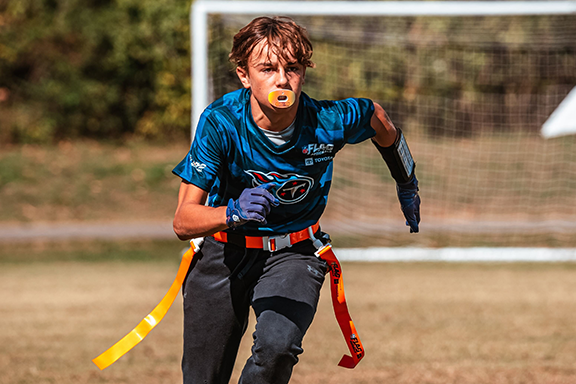
FLAG FOOTBALL RULES
This section details all the important flag football rules you need to know, while breaking down the different terms and positions.
Spring 2025 Rulebook and Tournament Guidelines
Quick Links: WHAT ARE THE RULES OF FLAG FOOTBALL? | NFL FLAG FOOTBALL RULES | 7 ON 7 FLAG FOOTBALL RULES | FLAG FOOTBALL TERMS | FLAG FOOTBALL EQUIPMENT | FLAG FOOTBALL POSITIONS | FLAG FOOTBALL PENALTIES
WHAT ARE THE RULES OF FLAG FOOTBALL?
The first rule of flag football is pretty straight forward: there’s no contact allowed. That includes tackling, diving, blocking, and screening. Instead, players wear flags that hang along their sides by a belt. To “tackle” the person in possession of the ball, the opposing team needs to pull one or both of their flags off.
While flag football rules are designed to keep players safe, you’ll find that they also create an engaging, fast-paced version of football without the physical contact.
Here’s a list of basic flag football rules:
-
All passes must be forward and received beyond the line of scrimmage.
-
Direct handoffs as well as unlimited backward pitches and passes are allowed behind the line of scrimmage. No backwards passes or direct handoffs are allowed past the line of scrimmage.
-
The quarterback has 7 seconds, from receiving the snap, to release the ball. Once a backwards handoff, pass or lateral occurs, the 7 second rule goes away and the offense has an unlimited amount of time to throw a forward pass.
-
The player receiving the snap (QB) cannot run across the line of scrimmage with the ball. The QB can hand off or pitch/throw the ball backwards to a teammate and then catch a forward pass across the line of scrimmage.
-
Offensive players must steer clear of the rusher and may not get in his/her way.
-
A maximum of 2 designated defensive rushers may legally rush the quarterback. All designated rushers must identify themselves, with their hand raised until the snap, to legally rush from the 7 yard rush line. Designated rushers are not obligated to rush, but if they do, they must rush immediately upon the ball being snapped.
-
Once the ball is handed off, pitched or thrown backwards by the offense, all defenders are eligible to rush across the line of scrimmage.
-
Interceptions are returnable for 6 pts. during a scrimmage down or for 2 pts on any extra point attempt. A backwards pass intercepted in the air, behind the line of scrimmage, can also be advanced by the defense for a score.
-
The ball is dead when it hits the ground, the offensive player’s flag is pulled from their belt, the ball-carrier steps out of bounds, or the ball-carrier’s body—outside of their hands or feet—touches the ground.
-
All offensive flag football penalties result in a loss of down and yardage.
-
All defensive flag football penalties result in an automatic first down and some are associated with yardage.
For a complete list of flag football rules, download the NFL FLAG Football Rule Book.
NFL FLAG football is a non-contact sport. There’s no tackling, diving, blocking, screening or fumbles.
NFL FLAG FOOTBALL RULES
One of the first questions families ask us is: how many players are on a football team? NFL FLAG football teams compete 5 on 5, but you may find various leagues out there—6 on 6, 7 on 7, 9 on 9—depending on the region and age group. NFL FLAG football rules allow up to 10 players total per team.
To accommodate a smaller team size, a flag football field is shorter than a typical football field at 30 yards wide and 70 yards long, with two 10-yard end zones and a midfield line-to-gain.

Here’s a quick overview of how to play flag football: Every game begins with a coin toss to determine which team will start with the ball (there’s no kickoff per NFL FLAG football rules). Games are two 15 to 25 minute halves, depending on the league, and the clock only stops for injuries, half-time and timeouts (each team has one 60-second timeout per half).
The starting team begins on its own 5-yard line and has four downs (essentially four plays) to cross midfield for a first down. If the offense fails to advance after three tries, they have two options: they can "punt," which means they turn the ball over to the opposing team who starts its drive from its own 5-yard line, or they can go for it. But if they still fail to cross midfield, the opposing team takes over possession from the spot of the ball.
If the offensive team crosses midfield, they have three downs to score a touchdown. The rules of flag football only differ slightly from tackle when it comes to scoring: a touchdown is 6 points and a safety is 2 points (1-point conversion from the 5-yard line; 2-point conversion from the 10-yard line).
WHO CAN PLAY NFL FLAG FLAG FOOTBALL?
If you ask any flag football coach what they like most about the game, you’ll typically hear the same answer: it’s incredibly inclusive. Kids of all abilities can learn flag football rules.
They don’t need a specific build, or even prior football experience. If they’re motivated and a team player, they can learn. Plus, it’s a great source of exercise that improves cardiovascular health, hand-eye coordination, and strength.
NFL FLAG offers leagues for boys and girls from 5 to 17 years old. There are several co-ed leagues as well. While flag football is a growing youth sport nationwide, you’ll find that it’s increasingly popular in the northeast.
Even more, flag football has opened doors for female athletes who want to play football. In 2010, flag football became a growing high school sport among female athletes in various parts of the country, and participation has increased since then. In fact, the National Association of Intercollegiate Athletics (NAIA), in collaboration with the NFL and Reigning Champs, launched the first college sanctioned women’s flag football league in the spring of 2021.

7 ON 7 FLAG FOOTBALL RULES
Even though several leagues follow basic flag football rules, you won’t find one standardized rule book across all organizations—mostly because there are many different versions of flag football out there. So, some 7 on 7 flag football rules may differ from 5 on 5, for example.
Generally, highly-competitive leagues with larger teams tend to adopt more lenient rules. College teams and some other flag football leagues compete 7 on 7 and allow certain types of contact, like open arm blocking and holding the chest. Other teams might allow contact above the hip and below the neck. That’s why some 7 on 7 flag football rules require players to wear soft shell helmets.
Youth leagues, on the other hand, usually follow similar rules as NFL FLAG football, which is strictly no-contact. The best way to learn about your league’s 7 on 7 flag football rules is to receive a copy of the rule book. But if you’d rather skip the fine print (we don’t blame you), go directly to the coach.
FLAG FOOTBALL TERMS TO KNOW
If you’re new to flag football—or football in general—phrases like “flag guarding” probably sound a little confusing. But it’s important to understand the meanings behind these common flag football terms, especially when you’re learning flag football rules. Plus, it makes watching the game that much more fun.
To make it easy, we’ve broken down these flag football terms into two categories: those that explain how the field is set up and those that explain how the game is played.
FLAG FOOTBALL FIELD TERMS
Boundary lines: The outer perimeter lines around the field, including the sidelines and back of the end zone lines.
Offense: The team who has possession of the ball and is trying to advance to the opponent’s end zone for a touchdown.
Defense: The team who doesn’t have possession of the ball and is trying to prevent the other team from scoring by pulling the ball-carrier’s flags down.
End zone: The two end zones, located on opposite sides of the field, are the scoring areas. The goal line, which a player must cross to score a touchdown, is the start of the end zone.
No run zone: The rules for flag football include no run zones that are located five yards before each goal line and the midfield. If the ball is spotted within a no run zone, the offensive team must use a pass play to earn a first down or touchdown. The objective is to prevent power football in tight spaces, limiting contact.
Line-to-gain: The line the offense must cross to get a first down or score.
Line of scrimmage: This is an imaginary line that expands the width of the field and runs through the point of the football. It indicates where teams can’t cross until the play has begun.
Backfield: The part of the field directly behind the line of scrimmage
FLAG FOOTBALL GAME TERMS
Dead ball: This refers to the period of time directly before or after a play, when the ball isn’t in motion. Flag football rules are more strict about deadlines: they commonly happen when the ball touches the ground, the ball-carrier’s flag is pulled from their belt, the ball-carrier steps out of bounds, the ball-carrier’s body—outside of their hands or feet—touches the ground, the pass is incomplete, the ball-carrier’s flag falls out or the receiver has one or no flags when catching the ball.
Downs: A down is the period after the ball is snapped and the team is attempting to advance down the field. In flag football rules, teams have four downs to cross midfield. If they successfully cross midfield within four downs, then they have three downs to score a touchdown.
Flag guarding: This flag football term happens when the ball-carrier prevents a defender from pulling down their flags. For example, they might stiff arm, cover their flag with their open hand, or lower their elbow. It is illegal and results in a penalty.
Lateral: A backward or sideway toss of the ball by the ball-carrier. Reminder: laterals are not permitted according to youth flag football rules.
Live ball: This is the period of time when the ball and play is in motion. It’s generally used in regard to penalties—live ball penalties are enforced before the down is considered complete.
Passer: The passer is the person throwing the ball. This flag football term is more common in flag football because the passer doesn’t necessarily have to be the quarterback.
Rush line: An imaginary line running across the width of the field seven yards (into the defensive side) from the line of scrimmage.
Rusher: The defensive player assigned to rush the quarterback to prevent him/her from passing the ball by pulling his/her flags or blocking the pass. Offensive players must steer clear of the rusher. When the ball is handed off, pitched or passed backwards, any defender may rush.
Shovel pass: A shovel pass is simply a legal forward pass (overhand or underhand) directly to a receiver, who must be across the line of scrimmage.

FLAG FOOTBALL EQUIPMENT
Forget the helmet, the shoulder pads, the bulky gear. Welcome to flag football, where all you need is a few simple items to get in on the action. Here’s a checklist of essential flag football equipment:
-
Flag football flags and belt. Every player needs a flag football set, including flag football flags and belt. There are a few different kinds of flags for flag football on the market—some are held onto the belt by velcro, others by a pop socket that emits a noise when pulled.
-
Shorts. Players wear shorts without pockets to avoid penalties and finger injuries.
-
Mouthguard. The rules of flag football require a mouthguard, and it’s the only protective gear that players wear.
-
Football cleats. Metal cleats are not allowed in most flag football leagues.
-
Football gloves. Not required, but definitely a plus!
Learn more about flag football equipment, including the different kinds of flag football flags.

FLAG FOOTBALL POSITIONS
Picture a traditional offensive line in tackle football, all 11 players. Now, remove the linemen. This is where the idea of 5 on 5 flag football comes from—it’s essentially the shell of tackle football, without the linemen. In other words, from an offensive standpoint, everyone can catch the pass, creating a continuous, fast-paced game. Here’s a closer look at flag football positions, and what skills are needed for both offense and defense:
OFFENSE
Typically, teams set up in a formation with these 5 positions:
-
Quarterback
-
Center
-
Wide receivers, running backs, or a mix of both
At the start of a play, the center snaps the football back to the quarterback, who can either hand it off or throw it. One question we hear frequently is: Can the QB run in flag football? No, most youth flag football rules don’t allow the quarterback to directly run with the ball. They must hand it off behind the line of scrimmage, or complete a forward pass. But if handed off, the quarterback can then run to receive a pass. The center is also allowed to run for a pass.
While 5 on 5 flag football leagues typically don’t have offensive linemen, 7 on 7 or 9 on 9 might offer this position. Exactly how does offensive linemen work in flag football? Like tackle, they’re responsible for protecting the quarterback and buying him/her more time to find an open player.
Of any rules, though, you’ll find that flag football blocking rules differ the most from league to league, with some allowing forms of contact.
If it is allowed, here’s how to block in flag football: Instead of launching forward at the snap, blocker’s use quick footwork and lateral movements to disrupt the defensive player’s path. Their hands are up and palms are open—arms can’t be crossed or fully extended.
DEFENSE
Without linemen in the mix, there are really two kinds of flag football defensive positions: rushers and defensive backs. Rushers try to get to the quarterback as quickly as possible, while defensive backs line up to face wide receivers, or even farther back as safeties.
What is a safety in flag football? The safety is an essential defensive position who acts as a catch-all, covering deep throws and any players who get loose. They’re responsible for keeping offensive players in front of them and covering players who slip through the cracks.
Coaches typically teach both man-to-man and zone defensive strategies. But the most important skill players learn on defense is the proper way to pull off an opponent’s flags. This technique actually lays the foundation for tackle football. For example, when breaking down, players are taught how to square up their opponent, where to align their head and knees, and what angles to take when pulling off flags. Essentially, it’s the exact position an athlete would need to take to physically tackle their opponent. This is a transferable skill set that benefits players who eventually want to play tackle football.
FLAG FOOTBALL PENALTIES
Offensive and defensive penalties are called and enforced by the officiating crew. Spot fouls are assessed from the yard line on the field where the foul occurred.
Most penalties are marked off from either the spot of the foul or previous play's line of scrimmage.


➡️ EQUIPMENT LIST
Get the season started on the right track with our flag football equipment checklist, including flag football flags.

➡️ HOW TO PLAY
Find an NFL FLAG near you. Just enter your zip code to get started!